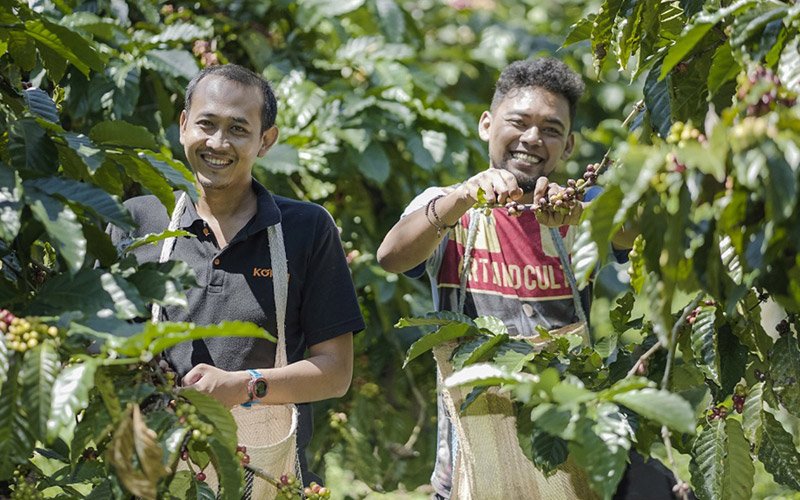Coffee Guideline 101: Growing a Coffee Plant By Fnb Tech Expert!
Coffee is one of the lucrative plantation commodities, not only at the national level but also at the international level. At the national level, coffee shops are easy to find in every region of Indonesia. Most of them use local farmers’/cultivators’ products, which makes young people interested in growing a coffee plant because it impacts the local culture.
Table of Contents
Factors That You Must Consider in Growing a Coffee Plant

1. The Selection of Types and Varieties
Coffee plants have many types and can reach thousands. Each type has different characteristics:
- Arabica Coffee: The most preferred because the taste is considered the best. The ripe fruit is bright red. Yield (percentage of final product and yield) is around 18-20%.
- Robusta coffee: Faster to harvest than Arabica. Fruit is round in shape. There is a tendency for the red colour to be dark. The yield is high (22%). It is cheaper than Arabica in terms of price.
- Coffee Liberica: Its prestige is still inferior to Arabica and Robusta. The fruit size is uneven, and the yield is meagre (12%). But can grow well in the lowlands.
- Coffee Excelsa: Can thrive in the lowlands and even on peatlands. Resistant to drought. The fruit’s skin is soft, so it is easy to peel. In 2006, Excelsa was considered a part of Liberika.
Also Read: 8 Types of Coffee Beans in Indonesia, Unique & You Must Try!
Apart from the technical side of the cultivation of coffee, another thing to consider is the selling price of the final product. Arabica coffee tends to be priced higher than other types. However, robusta has the highest productivity, and the yield is also high.
2. Preparation of Growing a Coffee Plant
Depending on the type, you can plant coffee plants in the high and lowlands. In general, coffee requires loose soil that is rich in organic matter. To increase fertility, give organic fertilizer and soil fertilizer around the plant area. Arabica will grow well at a soil acidity of 5-6.5 pH, while robusta will grow at an acidity level of 4-5.
The thing that you must prepare before starting coffee cultivation is to plant shade trees. Use shade trees to adjust the intensity of incoming sunlight. Coffee plants, including plants that require sun intensity, are not full.
The shade trees often used in growing a coffee plant are dadap, lamtoro, and sengon. Choose shade trees that don’t require much maintenance and whose leaves can be a great source of green manure.
It is recommended to plant Sengon protection trees four years before coffee cultivation begins. At the same time, the type of lamtoro can be faster, about two years earlier. Actions required to care for shade trees are leaf pruning and thinning.
Also Read: Best Climate For Growing Coffee, There are Interesting Facts
3. Planting Coffee Seeds
When the land, shade trees, and seedlings are ready, the next step is to transfer the seeds from polybags to planting holes in the garden area. The recommended spacing for coffee cultivation is 2.75×2.75 meters for robusta and 2.5×2.5 meters for Arabica. This spacing varies with the height of the land. The higher the land, the rarer it is, and the lower it is, the closer the spacing is.
Make a planting hole with a size of 60x60x60 cm, making this hole 3-6 months before planting. When digging the planting hole, separate the top and bottom excavated soil. Leave the planting hole open.
Mix 200 grams of sulfur and 200 grams of lime two months before planting with the bottom-dug soil. Then insert it into the planting hole. About one month before the seeds are planted, mix 20 kg of compost with the top-dug soil, then put it in the planting hole.
4. Harvesting Coffee
If all the processes are carried out intensively, the next step of growing a coffee plant will produce results in less than five years. It depends on the type of coffee you grow. For robusta coffee, the fruit will begin to appear at the age of 2.5 – 3 years. In comparison, Arabica is aged three years – 4 years.
After the fruit is ripe, you can start the manual harvesting process, directly picking the fruit from the tree. Unfortunately, it usually can not produce in large quantities when the first harvest. But the coffee plant will continue to bear fruit until it reaches peak production at 7 – 9 years old.
One harvest period generally lasts between 4-5 months. During this period, you should pick about every 10-14 days until the plants do not bear fruit anymore.
3 Steps Of Coffee Plant Care

1. Balanced Fertilization
The purpose of fertilization is to meet the nutrient needs of coffee plants and improve the structure of the growing media conditions. If these nutrient needs are unmet, they will stunt plant growth, make it thin, wilted, and unproductive.
Fertilization of coffee plants must be done correctly, both at the right time, in the right type, in the correct dose, and in the proper administration. Usually, frequency of fertilization is done two times a year, namely at the beginning and end of the rainy season.
2. Pruning
Pruning removes some parts of the coffee plant that are considered diseased, disabled, and unproductive. It aims to increase the productivity of the coffee tree and clean up weeds that grow around it. The pruning process can be done two times a year and simultaneously with loosening the soil.
3. Wiwilan
For coffee to produce a large capacity of fruit, the wiwilan stage is also necessary. There are two types of wiwil for coffee plants: coarse wiwil done every month and fine wiwil every 3-4 months.
The wiwilan method removes branches with poor growth, such as water shoots and fan branches, in the hope of doing wiwilan so that growing a coffee plant are not generatively disturbed so that they can bear fruit, healthy and pithy.
Guarantee Your Best Coffee Beans in Town!
FnB Tech Indonesia is here to satisfy every coffee connoisseur with the best coffee beans. Our single-origin coffee beans are only sourced from an area of Indonesia with a long history of cultivating coffee, and we sustain enduring connections with reliable producers. A few hundred workers help FnB Tech Indonesia process coffee beans for shipment worldwide.











